The trend continues to accelerate – even faster now. Cloud computing was already booming before 2020. But in the following two years, remote work flourished, and cloud adoption soared.
Some companies have since returned to the office. Others are adopting hybrid models, where staff work from home and in the office.
Yet there’s more to the rise and rise of cloud computing than remote working.
For example, cloud infrastructure also supports big data analytics, Artificial Intelligence (AI), Machine Learning (ML) models, the Internet of Things (IoT), and advanced Business Intelligence (BI). So, we compiled the following remarkable cloud computing statistics from reliable sources to help you keep up-to-date.
We’ve also included tips, tricks, and tools to make cloud computing work for you. Yes, that includes practical tips on how to manage and optimize your cloud costs across AWS, Azure, GCP, Kubernetes, and Snowflake within a single platform.
Related article: “The 15+ Best Cloud Cost Management Tools”
Top Picks
- Globally, the cloud computing market will surpass $1 trillion by 2028. (Precedence Research)
- The global cloud computing market grew from $24.63 billion in 2010 to $156.4 billion in 2020. That’s a 635% jump.
- Over 20% of organizations say they have little to no idea how much different aspects of their business cost as it relates to the cloud (CloudZero, The State of Cloud Cost in 2024)
- A cloud bill can comprise hundreds of millions or billions of rows of data (FinOps Certification)
- An Amazon Cost & Usage Report is too large to load into Excel all at once. Instead, Amazon splits its monthly CUR into many separate files. Good luck understanding them. (FinOps Certification)
- 97% of enterprise cloud apps are unsanctioned, because departments, teams, or employees purchase new tools to support their productivity efforts. (Osterman Research)
- Modernizing and integrating apps with public cloud services is a top priority in the next three years. (VMware)
- You can reduce your Total Cost of Ownership (TCO) by as much as 40% by migrating your business to the public cloud (Accenture).
- 80% of organizations are using multiple public or private clouds. (Virtana)
- The world creates 2.5 quintillion bytes of data every day. (Osterman Research)
- Fun Fact: A “FinOps Hug”: A state of harmony between finance and engineering teams.
Let’s dive right into it, shall we?
Cloud Adoption Stats: How Many Companies Use Cloud Computing?
Most organizations, particularly enterprises, have at least some of their workloads in the cloud.
More than 90% of organizations use the cloud (Source: O-Reilley)
O’Reilly’s latest Cloud Adoption report had some interesting numbers. Consider this:
- About two-thirds of respondents currently operate in a public cloud and 45% use a private cloud — versus 55% who still rely on traditionally managed on-premises systems.
- 48% plan to migrate at least half of their applications to the cloud in the next year; 20% intend to move all their applications to the cloud.
- 47% are pursuing a cloud-first strategy; 30% are already cloud-native; 37% intend to be cloud-native in about three years.
- Only 5% plan on switching from the cloud to on-premises infrastructure (cloud repatriation).
Cloud-based workloads account for 75% of workloads in 1 out of 5 organizations (Source: Fortinet 2021)
About 39% of respondents are already running at least half of their workload on the cloud. Another 58% said they planned to run that much workload in the cloud in the next 12-18 months.
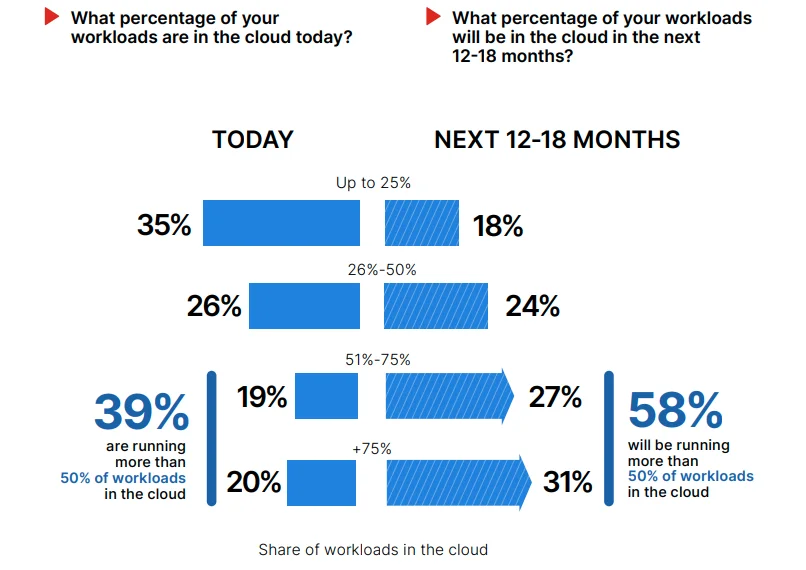
Credit: Fortinet’s survey of the percentage of workloads businesses run in the cloud in 2022
By 2023, 31% of organizations expect to run 75% of their workloads in the cloud. Some 27% of them plan to run at least 50% of their business processes in the cloud by then.
Cloud adoption among enterprise organizations is over 94% (Source: RightScale)
More than 94% of organizations with more than 1,000 employees have a lot of their workloads in the cloud, according to this survey of 800 organizations. The latest edition shows enterprise cloud computing continues to grow rapidly — and then some. For example:
- More enterprises are exploring a multi-cloud or hybrid cloud approach rather than just using a public cloud or private cloud strategy. More on this later.
- 54% will move their workloads to the public cloud in 12 months.
There’s more.
Organizations with 1,000 or fewer staff invest big in the cloud (Source: TechRepublic)
About 44% of traditional small businesses use cloud infrastructure or hosting services. That’s compared to 66% of small tech companies and 74% of enterprises.
There is one more thing. The public cloud will host 63% of SMB workloads and 62% of SMB data within the next year.
The U.S. and Western Europe still dominate cloud computing (Source: ReportLinker)
Combined, these two regions account for 82% of the world’s cloud computing. This chart shows cloud adoption by country and region according to Gartner:
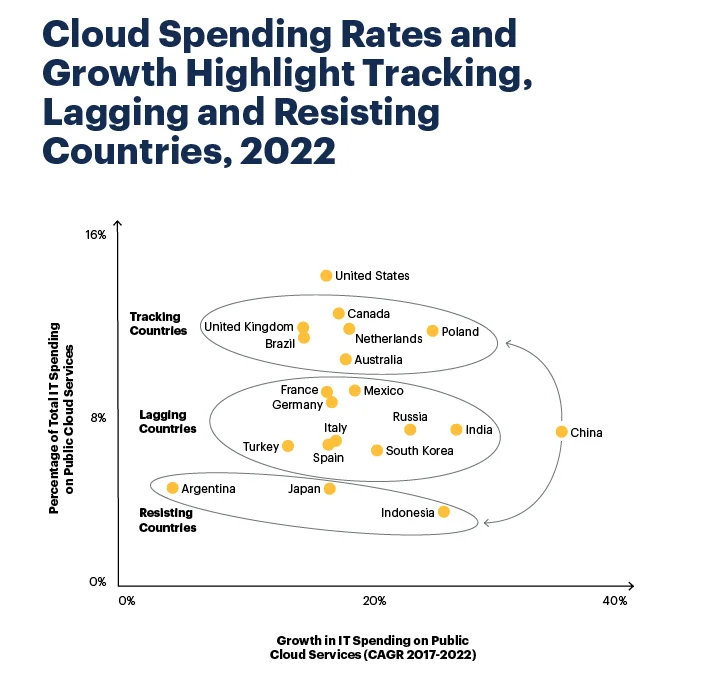
Credit: Gartner 2022
40% of organizations in developing regions are currently evaluating and planning cloud strategies (Oracle and IDC)
The cloud computing industry is not just booming in developed economies. According to new Oracle findings, cloud computing is rapidly developing in Sub-Saharan Africa (SSA) as well as in the Central and Eastern Europe (CEE) regions.
As of now, 30% of respondents said they use the cloud. Among companies with more than 2,500 employees, half are planning or evaluating cloud strategies as are 41% of those with 1,000 to 2,500 employees.
Cloud Computing is becoming more popular across lines of business teams (Oracle and IDC)
Lines of business (LoBs) are even more involved (40%) than IT (38%). That’s a good thing. Both units are leveraging the cloud’s power in different areas of their organizations more than they used to.
Why Are Companies Adopting Cloud Computing So Fast?
Organizations are moving to the cloud for a variety of compelling reasons. Cloud computing offers several powerful benefits, including:
Cloud computing boosts gross margins and profitability (Source: Wipro FullStride)
In its global survey of 1,300 C-Suite executives, Wipro FullStride Cloud Services showed that a well-executed move to digital increased revenue and profitability.
While SaaS companies reported the highest margins, others also enjoyed notable gains. As an example, finance executives reported revenue increases of up to 15% and profitability increases of up to 4%.
Another survey by Deloitte showed small and medium businesses that used cloud computing made 21% more profit and grew 26% faster.
Cloud computing generates more revenue (Source: Infosys)
The survey also noted that migrating to the cloud helps unlock additional revenue streams that can boost profit growth by as much as 11.2% year-over-year.
Here’s the kicker. The survey concluded that your organization needs to have at least 60% of its workload in the cloud to realize noteworthy financial gains.
Achieve faster time to market (Source: IBM)
Some 65% of respondents who identified as “Optimizers” told IBM that cloud computing helped them reduce time to market. Check this out:
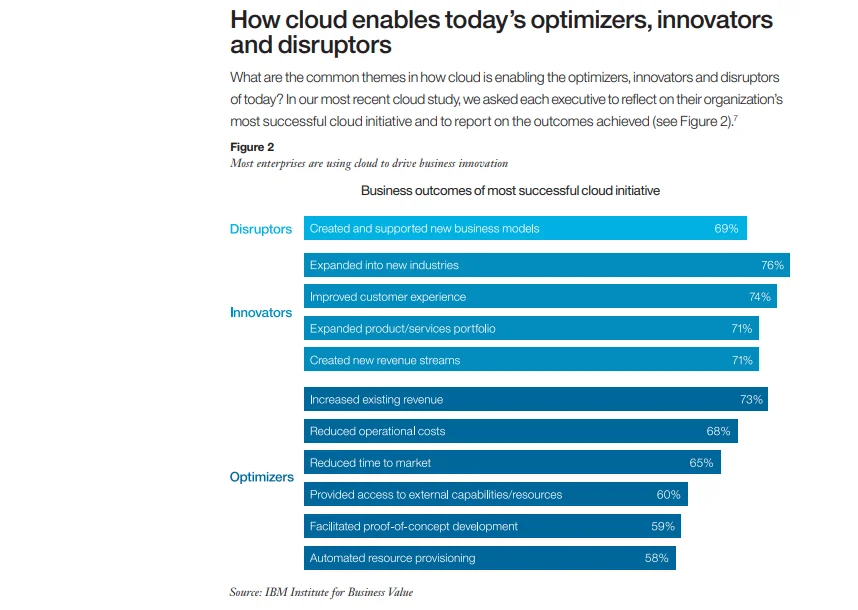
Credit: IBM’s Beyond Agility – How Cloud is Driving Enterprise Innovation Report
Reduce startup costs (Source: OpsRamp)
Cloud computing reduces upfront startup costs, including setup and maintenance costs.
- 94% of IT professionals in an OpsRamp survey said that is true for them.
- Accenture also found that moving workloads to the public cloud lead to Total Cost of Ownership (TCO) savings of 30-40%.
Also, operating in the cloud converts your Capital Expenditure (CapEx) to Operating Expenditure (OpEx), freeing more resources to fund your operations and growth.
6 in 10 CxOs say cloud computing improves security (Source: Oracle)
Security is the top benefit of cloud computing, according to 60% of C-Suite executives — ahead of cost savings, scalability, ease of maintenance, and speed.
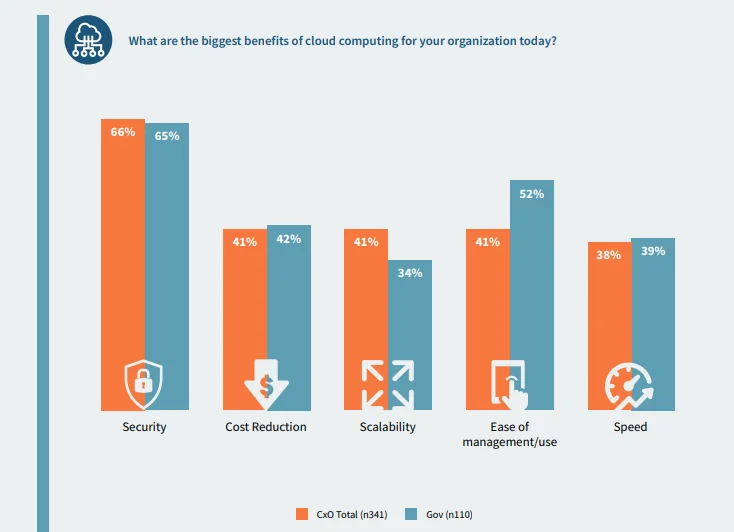
Credit: Oracle’s Security in the Age of AI Report
It makes sense, considering they also cited human error as the most significant threat to security. The cloud supports automation, which reduces the risk of human errors that cause security breaches.
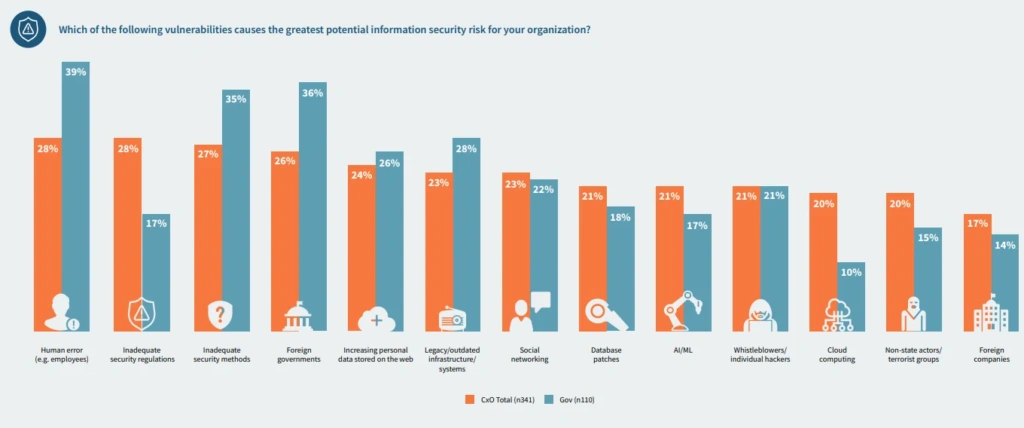
Credit: Oracle
Moving to the cloud improves business resilience (Source: Aberdeen)
Cloud-based solutions support business resilience best practices such as remote working, pivoting to a new business model, and disaster recovery.
For example, Aberdeen found that cloud-based businesses could resolve disaster recovery issues in just 2.1 hours, as opposed to 8 hours for businesses that didn’t use cloud services.
The cloud boosts flexibility (Source: OpsRamp)
Out of 137 IT executives surveyed 115 said they planned to migrate more workloads to the cloud in the next 24 months.
- 62% said they’ll do so for more flexibility and scalability.
- 47% cited wanting more cost management using elastic resource provisioning.
Migrating to the cloud reduces carbon emissions by 84% (Source: Accenture)
According to Accenture, organizations with persistently high environmental, social, and governance (ESG) scores enjoyed 4.7x larger operating margins versus low ESG performers between 2013 and 2019.
By moving to Infrastructure-as-a-Service (IaaS), eco-friendly brands can reduce carbon emissions by up to 84% and energy consumption by up to 64%.
Accenture made this chart to compare carbon emissions between cloud vs on-premises operations:

Credit: Accenture
Cloud Spending Statistics
All sizes of organizations are making significant investments in cloud computing to take advantage of its benefits. You can see what that looks like here:
Over 50% of SMEs technology budget will go to cloud spend in 2023 (Source: Zesty)
SMEs spent 47% of their technology budgets on cloud services in 2022, a 67% increase from 2021 to 2022. In 2023, their cloud investment will surpass 50% of their tech budget.
Cloud spending to reach nearly $600 Billion in 2023 (Source: Gartner)
In 2023, Gartner estimates global end-user spending on public clouds will reach over $599 billion, up from $421 billion in 2021 and nearly $500 billion in 2022.

Credit: Gartner’s Worldwide end-user cloud spend forecast 2021-2023
The forecast also shows IaaS, DaaS, and PaaS, respectively, will see the highest growth in spend during the period.
31% of enterprises spend over $12 million on public cloud services every year (Source: RightScale 2022)
Most enterprises have a lot of workloads running in the cloud — and they are investing to host it there. This survey shows enterprise plans to increase their cloud budgets to support this drive into the future.
54% of small and medium-sized businesses spend more than $1.2 million on the cloud (Source: RightScale)
RightScales’s findings also show a noteworthy increase in SMBs that spend more that $1.2 million annually compared to 38% two years ago.
Also, IDC predicts SMBs will increase their cloud spend by 31% to support further adoption.
Cloud costs are higher than expected for 6 in 10 organizations (Source: CloudZero)
As companies invest more in the cloud, only 4 in 10 organizations have their cloud costs around where they expect.
Some 490 out of 1,000 respondents said their cloud costs were a little higher that where they should be while 110 reported cloud costs were way too high.
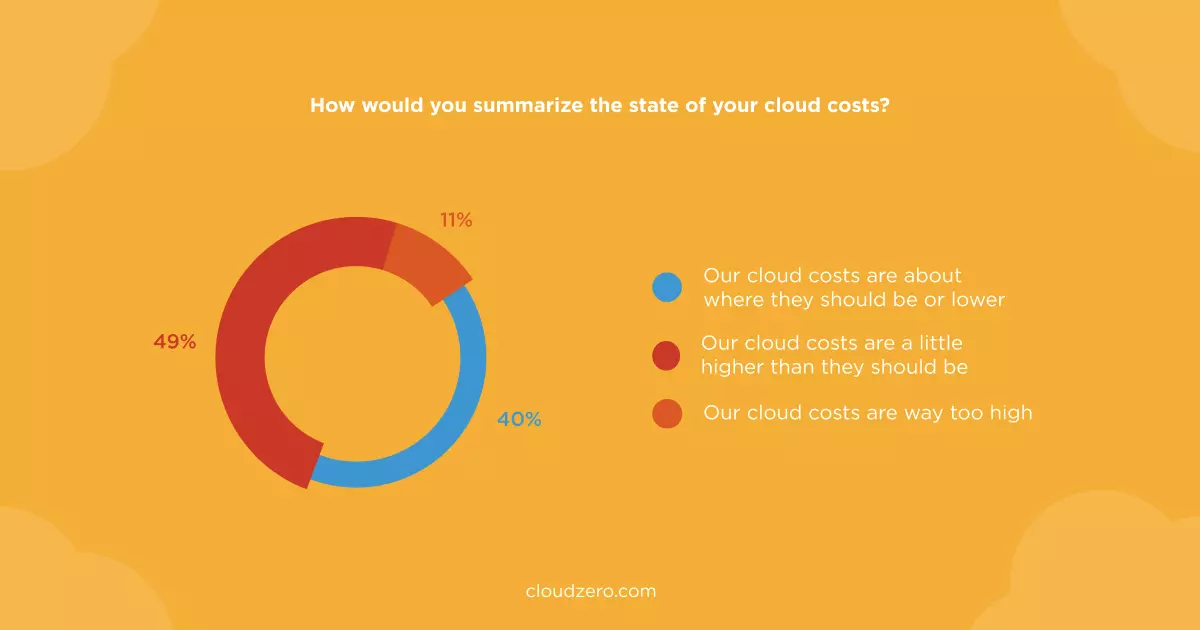
Credit: CloudZero’s 2022 State of Cloud Cost Intelligence Report
71% of organizations expect their cloud spend to increase (Source: Flexera)
Some 58% of all respondents in the survey of 501 IT executives worldwide expect a slight increase in cloud spending. Some 13% of them expect a significant increase. Compare that to just 2% who expect a significant decrease and 10% who expect a slight decrease in their cloud spend.

Credit: 2022 Tech Spend Pulse
58.7% of IT spending is still traditional but cloud-based spending will soon outpace it (Source: Gartner)
According to Gartner, traditional IT spending still dominates cloud spending. However, its 2019-2025 forecast predicts cloud-based spending will continue to grow while traditional IUT spending will continue to shrink, eventually falling behind cloud spend from 2025.

Credit: Gartner forecast on cloud spending growth vs traditional IT spending until 2025
But is all this spending really worth it? What kind of returns are companies getting from their cloud investments?
World Wide Waste: Cloud Waste Is A Big Problem
Cloud waste is shockingly prevalent today:
32% of a cloud budget went to waste (Source: Flexera)
Cloud waste averaged 30% of companies’ cloud budgets in 2021, according to Flexera. In 2022, that figure jumped to 32%. Considering Gartner’s estimation that cloud spend reached nearly $500 billion in 2022, that 2% increase might represent a massive amount of money in wasted cloud spend.

Credit: Wasted cloud spend, State of the Cloud Report by Flexera
75% of organizations report an increase in cloud waste (Source: StormForge)
Most companies reported that as their cloud spend increased, so did their cloud waste. The StormForge survey of 131 IT professionals shows cloud waste could be as high as 47% of a cloud budget.
49% of cloud-based businesses struggle to control cloud costs (Source: Anodot)
There’s more:
- In 54% of cases, cloud waste stems from a lack of visibility into cloud costs.
- According to 44% of executives, at least a third of their cloud spend is wasted.
- Complex cloud pricing is a challenge for 50% of respondents.
- Nearly half of respondents said managing multi cloud environments is challenging.
These challenges make controlling cloud costs even more difficult.
42% of CIOs and CTOs consider cloud waste the top challenge (Source: Zesty)
Some 42% of CIOs and CTOs struggle to manage resource usage.
Often, waste occurs from overprovisioning and inability to scale rapidly. This led to a 67% annual increase in amounts allocated to cloud services, increasing to 47% in 2022 from 29% in 2021.
Also, 58% of respondents said the most challenging aspect of managing cloud costs was finding the right cloud offering for their workload.
Over half of enterprises are struggling to see cloud ROI (Source: PwC)
About 53% of enterprises were yet to see “substantial value” from their investment in the cloud.

Credit: How much value do companies see from cloud investments? – PwC research
This is true for many organizations — and it can be aggravating for companies that moved to the cloud for cost savings.
1-3 years is the average payback period for cloud investment (Source: McKinsey)
Firms like McKinsey show companies might not see cloud benefits immediately. Instead, they can expect to gain significant benefits within 1-3 years of implementing cloud computing best practices.

Cloud Cost Optimization Statistics
With cloud spend wastage on the rise, many companies are seeking to reduce and optimize cloud costs to maximize their returns. The following revelations are mind-blowing:
7 out of 10 companies aren’t sure what they spend their cloud budget on (Source: CloudZero)
The 2022 State Of Cloud Cost Intelligence Report shows that only 30% of surveyed organizations knew where their cloud budget was going exactly — a truly grim picture of cost attribution in the cloud.
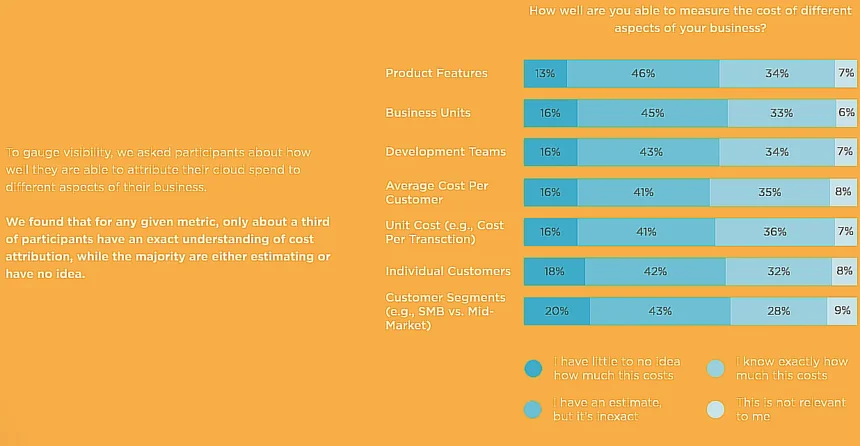
This means most companies struggle to allocate cloud costs accurately because they are not sure what, why, and who drives their cloud costs.
Also, the larger the company, the bigger the cost visibility problem was:
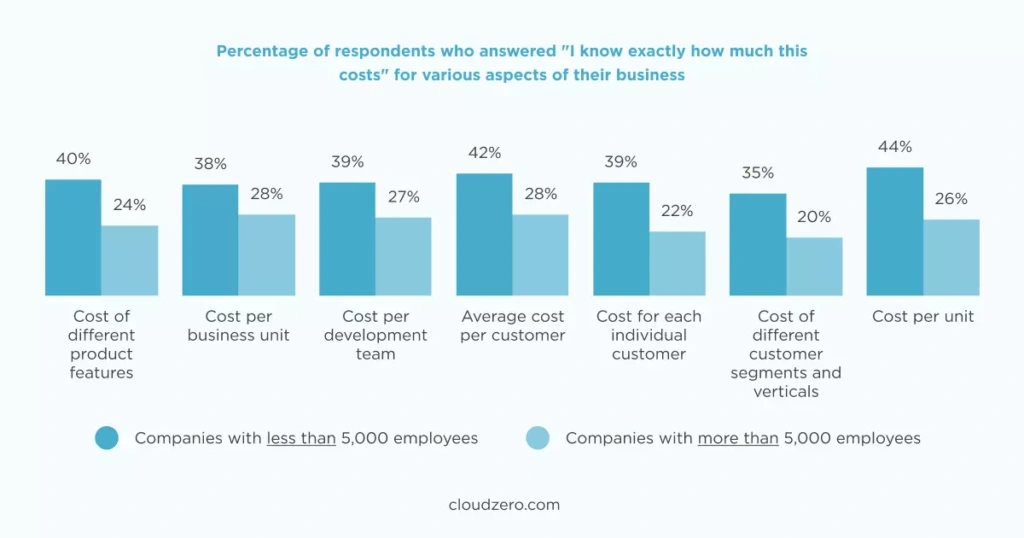
Compared to smaller organizations, larger organizations often have less understanding of how much exactly they spend on various business aspects.
The challenge highlights the need to adopt a robust cloud cost optimization solution like CloudZero. CloudZero’s cloud cost intelligence approach breaks down complex cloud bills into unit costs you actually care about and can make sense of. It then presents that data to you as:
- Cost per customer
- Cost per software or product feature
- Cost per team
- Cost per environment
- Cost per engineering project
- Cost per deployment, and more
The result: CloudZero empowers you to not only tell what, why, and who is driving your cloud costs, but to also connect your cloud costs to your business goals. That means CloudZero helps you pinpoint where to reduce usage or increase investment to cut costs or increase ROI, respectively.
Schedule a demo here to see CloudZero in action.
78% noticed cloud cost variance late (Source: CloudZero)
Only 22% of respondents said they were unable to detect cloud cost anomalies instantly or within minutes. Some 8% of respondents said they noticed cost anomalies after a week or more, 14% after days, and 56% in hours.
Only 23% see less than 5% cloud cost variance (Source: CloudZero)
In terms of how much cloud cost variance organizations are seeing, CloudZero found:
- 60 out of 1,000 respondents experienced more than 30% variance.
- About 230 saw cloud costs variance of between 15-29%.
- More than 480 saw cost anomalies that ranged between 55 and 14%.
Check this out:
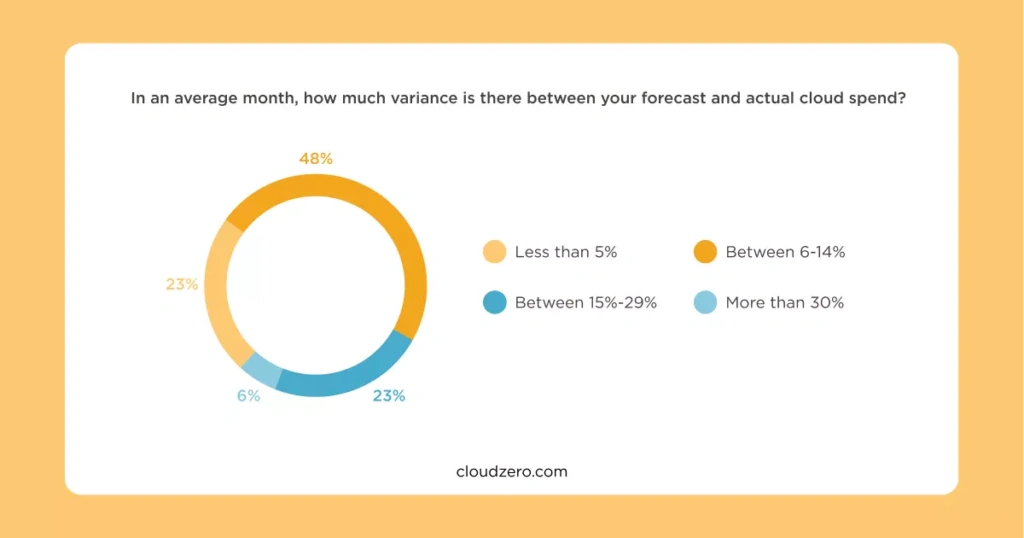
49% of business leaders cite measuring value as a major barrier to achieving cloud ROI (Source: PwC)
In addition, 48% of CFOs lack confidence in their ability to measure cloud ROI.
We see this as yet another cloud cost visibility issue because once you understand who, what, why, and how you spend your cloud budget, it is much easier to determine whether your investment is paying off.
For example, you can identify which processes, teams, or products consume the most cloud resources, analyze each one’s return on investment, and cut their spending in favor of the best performers.
24% measure cloud value in terms of faster innovation and delivery (Source: PwC)
Some 126 out of 524 technology leaders at Fortune 1000 companies told PwC that faster innovation and faster service/product delivery was the top way they measured the value of the cloud — followed by improved operational resiliency.
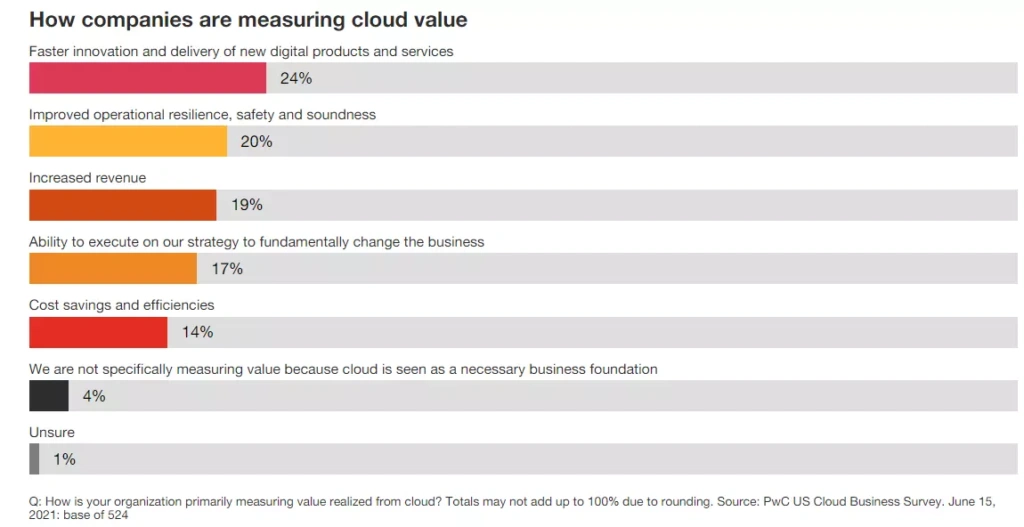
Credit: PwC Cloud Business Survey
59% use 3+ tools to manage and optimize their cloud (Source: Anodot)
This makes it tough to collect, analyze, and understand cloud resource usage with accuracy, let alone optimize utilization. Add to that adopting complex cloud-native technologies such as containers, Kubernetes, and microservices, and tracking costs becomes even more complicated.
63% of tech execs say cloud cost optimization is still key in 2023 (Source: Zesty)
The leaders are prioritizing cloud cost optimization to maximize their Cloud ROI. Since at least three years ago, most organizations with workloads in the cloud have made this a top priority, along with cloud security.
Statistics On Cloud Service Providers
The cloud computing market continues to attract more players and shift market share among them.
Amazon Web Services dominates with 34% market share (Source: Synergy Research Group)
AWS still holds over a third of the cloud services market:
- In Q2 2022, AWS commanded 34% of the cloud market, a 1% increase year-over-year. Azure is second with 21% of the market, followed by Google Cloud (10%), Alibaba (5%), and IBM (4%).
- Amazon’s revenue from AWS grew from 5.62% in 2014 to 13.24% in 2021.
- The survey also showed the cloud market continues to grow 34% year-over-year.
- Fun fact: It took Netflix seven years to migrate to AWS.

Credit: Cloud services market share in Q2, 2022
Competition between Azure and AWS is rife
Picture this:

- 83% enterprises use Azure vs. 77% for AWS.
- Enterprises are running more VMs on Azure than they are on AWS — 71% run more than 51 VMs on Azure vs 69% of enterprises that run VMs on AWS
Flexera also found 53% of enterprise users on Azure spend over $1.2 million each year vs. 52% on AWS.
Salesforce and Adobe are the most valuable SaaS companies today (Source: Mike Sonders)
Salesforce invented the modern SaaS model about 25 years ago, and provides some of the best SaaS tools for businesses today.
Despite Salesforce earning much more, Adobe recently overtook Salesforce as the largest public SaaS company by valuation, according to Mike Sonders.

Credit: Mike Sonders
Adobe has a market cap of $241 billion, while Salesforce is worth $220 billion in 2023, according to Mike Sonders. Then again, Salesforce made $31.4 billion in revenue for fiscal year 2023, an increase of 18% from the year before.
Adobe made $17.61 billion in fiscal year 2022, an increase of 15% over 2021 results. Discover today’s best SaaS companies in our snackable guide.
Diverse players are great at different offerings (Source: Synergy Research Group)
A deeper look into various cloud computing segments reveals that:
- AWS is the clear leader in the Infrastructure-as-a-Service (SaaS) segment.
- Azure is the provider to beat in the Platform-as-a-Service (PaaS) for enterprises segment.
- While AWS has made headway in the AI research, ML modeling, and IoT areas, Google’s GCP excels at these with its Deep Learning offerings and Tensor Processing Units (TPU) chips.
- Alibaba dominates in IaaS across the Asia Pacific region and is third globally after AWS and Azure.
- CloudFlare and Akamai also show up in the Content Distribution Network (CDN) space.
Consider this:

Snowflake is the most valuable data cloud today (Source: Mike Sonders)
According to the site, Snowflake has a market cap of $57 billion in 2023. It provides data lake and warehousing services and has been a publicly traded company since October 2020. The company generated $2.067 billion in revenue for fiscal year 2023.
In the same space is Databricks, which made over $1 billion in revenue for the year 2022. It’s data warehousing product alone crossed $100 million in annual recurring revenue (ARR) in April 2023. Its market cap dropped from $38 billion in 2021 to $31 billion after it trimmed its internal share price in October 2022. Databricks plans to go public soon.
Palantir is a leader in governing AI (Source: The Motley Fool)
Palantir Technologies provides Artificial Intelligence and data mining services. It owns AIP, Foundry, Apollo, and Gotham. Founded in 2003, Palantir made $1.91 billion for fiscal year 2022, a 24% year-over-year growth, with $31 million in GAAP net income.
54% of respondents use three different cloud storage providers (Source: GoodFirms)
The research firm had some interesting findings:
- About 300 out of 600 respondents said they use cloud storage for work although personal usage is on the rise.
- Google Drive, Dropbox, OneDrive, and iCloud make the four most used personal cloud storage services.
- 87.96% use cloud storage for website purpose compared to mobile apps at 89.35% and 10.65% for desktop apps.
The research also found that younger individuals were more likely to use cloud storage for personal use rather than for work purposes.
Statistics On Cloud Computing Models: IaaS, PaaS, SaaS
SaaS, IaaS, and PaaS cloud delivery models have dominated the cloud services market for the longest time. But new entrants are making a mark as more organizations strive to make cloud computing work for them.
The cloud market grew by 34% in Q1, 2022 alone (Source; Synergy Research)
Not only that, but Synergy Research Group reported the cloud computing market size surged 29% in Q2, 2022.
SaaS is still leading the charge. Yet, cloud services are booming across a range of sectors. That includes Desktop-as-a-Service (DaaS) and Business Process-as-a-Service (BPaaS. ).
It is also true that some cloud delivery models are growing more rapidly than others.
SaaS dominates cloud services delivery models (Source: Gartner)
The cloud application services market generated over $152 billion in end-user spending in 2021, by far the leader compared to IaaS ($91 billion), and PaaS ($86 billion). Gartner forecasts SaaS will generate more than $208 billion in end-user spending in 2023.
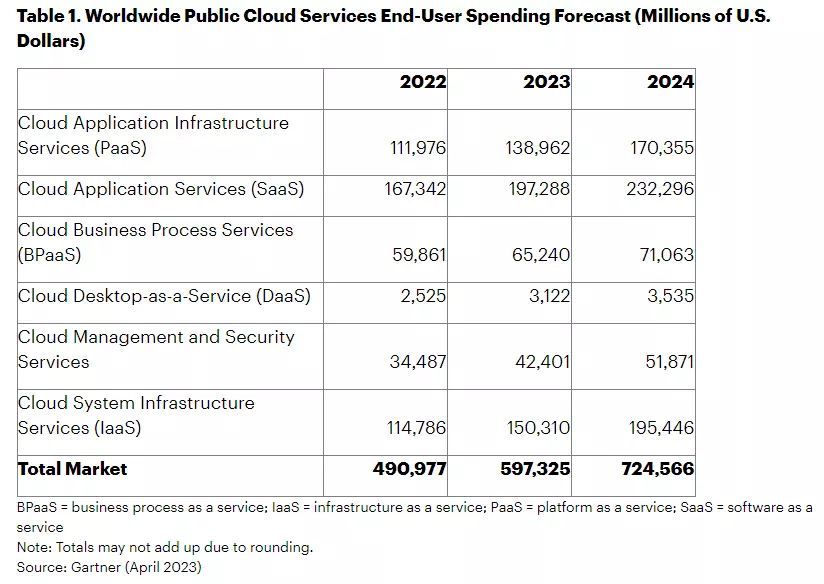
Credit: Cloud services growth forecast in 2023 – Gartner
IaaS to grow fastest at over 30%
The cloud applications infrastructure market will experience the fastest end-user growth from 2022, followed by DaaS (26.6%) and PaaS (26.1%), according to the Gartner forecast.
Google Cloud’s IaaS offering is growing the fastest at 63% (Source: Gartner)
While AWS dominated IaaS with a 38.9% market share in 2020/2021, GCP’s IaaS offering grew 63.7% followed by Huawei Cloud (56.3%), Azure (51.3%), and Alibaba Cloud (41.9%). AWS grew 35.6% between 2020 and 2021.
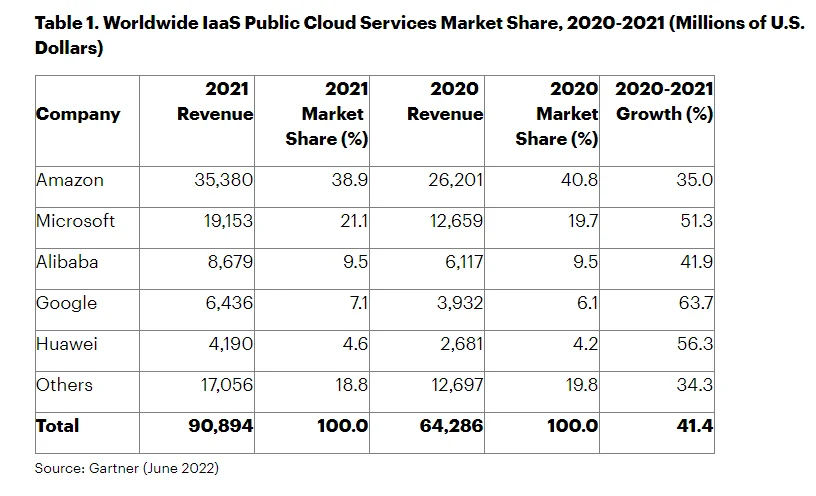
Credit: IaaS market share growth 2020/2021
Cloud Computing Strategy Statistics: Public Vs. Private Vs. Hybrid Vs. Multi-cloud
Organizations are using two or more clouds at the same time for a variety of reasons, as you’ll see here.
Multicloud and hybrid cloud statistics
Going hybrid or multi-cloud is not just about preventing vendor lock-in. Most organizations deploy a hybrid cloud (39% vs 36% last year) or a multi-cloud strategy (33%) to leverage multiple services, achieve scalability, or support business continuity.
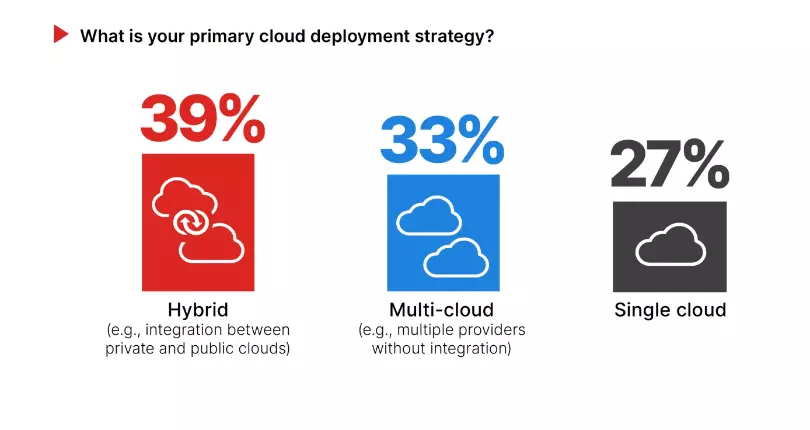
Credit: Fortinet
- Typically, organizations deploy or test on 3.4 public clouds and 3.9 private clouds. (Flexera)
- 4 out of 5 companies use two or more IaaS or PaaS providers. Some 86% have at least 11 SaaS providers, and a third have more than 50.
- 80% of organizations use multiple public cloud providers. (Virtana)
As a result, respondents told Virtana they had difficulty visualizing and controlling costs across multiple public and private clouds:
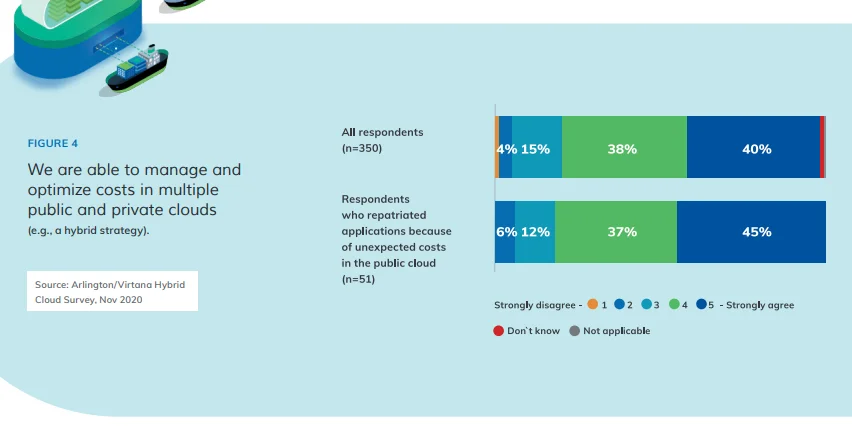
Credit: Virtana State of Hybrid Cloud
Public vs. private cloud statistics
Picture this:
- Sixty-seven percent of respondents say they use a public cloud, 55% maintain their own infrastructure on-premises, and 45% of organizations use a private cloud. (O’Reilly)
- Only 8% of organizations use just a single public IaaS provider. (Cisco)
Experts also expect cloud strategies to evolve from ‘private’ or ‘public’, to ‘dedicated’ or ‘shared’.
59% of tech Leaders use hybrid or multicloud for security (Source: Zesty)
CIOs, CTOs, and other tech leaders said they don’t want to depend on one vendor’s security protocols and believe their data is safer with multiple cloud providers.
- 56% of respondents said they wanted the unique technological advantages that a specific cloud provider offered
- 395 cited cost efficiency as a reason for adopting a hybrid cloud or multicloud strategy
So, which cloud provider dominates the private cloud market?
Azure dominates the private cloud now (Source: Flexera)
Microsoft Azure Stack usage grew to 37% in 2022 to dislodge VMware vSphere (31%) from the top spot, according to the State of the Cloud Report.
How Many Applications Do Companies Have In The Cloud?
Cloud usage statistics show evidence of SaaS sprawl, for example. Here are the findings:
A typical company is using 254 SaaS apps (Source: Productiv)
The average company has 254 SaaS apps, while enterprises have 364, according to a Productive study of over 30,000 apps.
- The average engagement over 60 days of licensed employees was 45%.
- That suggests that less than half use their app licenses regularly.
Notably, tools purchased outside of IT scored higher at 54% engagement. This may suggest employees find more value in the tools they choose on their own.
The typical employee is dabbling in 36 cloud-based services in a day on average
There’s more:
- The average department now has 40-60 tools, however cross-functional apps are the most popular.
- The average number of apps in the security, engineering, and IT departments is higher at 78, 77, and 61, respectively.
- IT departments do not own or manage 56% of SaaS applications.
So, which companies experience the most sprawl?
Most sprawl occurs in smaller, high-growth organizations
The reason for this may be because they are growing faster, with faster-evolving SaaS portfolios. The findings were as follows:
- 68% SaaS sprawl for companies with less than 500 employees.
- 52% SaaS sprawl for companies with less than 2,000 employees.
- 52% SaaS sprawl for companies with more than 2,000 employees.
Overall cloud services usage is likely to increase as cloud spend increases vs. on-premises spend as you can see in the next section.
On-Premises Spending Vs. Cloud Spend: What Share Of IT Spending Is Cloud-Based?
Even though on-premises spending still dominates IT spending, the gap is narrowing. Fast.
$8 out of every $10 for IT spend goes to cloud services (Source: McKinsey)
In 2024, most enterprises plan to spend $8 out of every $10 on cloud-based IT hosting. A separate Morgan Stanley survey found that cloud computing will see the highest growth in IT spending in 2022.
Traditional IT spending to shrink by 32% (Source: Morgan Stanley)
By 2022, only about 32% of all enterprise applications was expected to run on traditional servers, down from 50% in 2019, when companies preferred to own and operate onsite data centers. That shrinkage is likely to increase further in the next three years.
51% of IT spending is shifting to the public cloud (Source: Gartner)
The public cloud will replace traditional solutions for apps, infrastructure, business process services, and system infrastructure by 2025, compared to 41% in 2022.
- The amount spent on application software will increase from 57.7% to 65.9% in 2025.
- The percentage of cloud-based application software expenditures will rise from 57.7% in 2022 to 65.9% in 2025.
That said, which sectors of the economy are driving cloud services growth?
Cloud Monitoring Statistics
Cloud monitoring is a key component of cloud management. The cloud is dynamic and workloads are constantly changing, making it crucial to continuously monitor your application’s performance, security, and costs.
Here are some interesting cloud computing statistics to know in this area:
Multiple tools are challenging to manage for organizations (BetterCloud)
Teams manage their cloud environments using multiple tools, according to the 2022 State of SaaSOps. This leads to complexity, mix-ups, and insufficient visibility. Instead, integrate your cloud monitoring tools so you can easily analyze the information in one place.
For example, CloudZero offers a single pane of glass to view, understand, and act on all your cloud costs. You can collect, analyze, and understand your AWS, Azure, and GCP costs in one place. In addition, you can view your platform costs from Kubernetes, Snowflake, MongoDB, Databricks, Datadog, and New Relic.
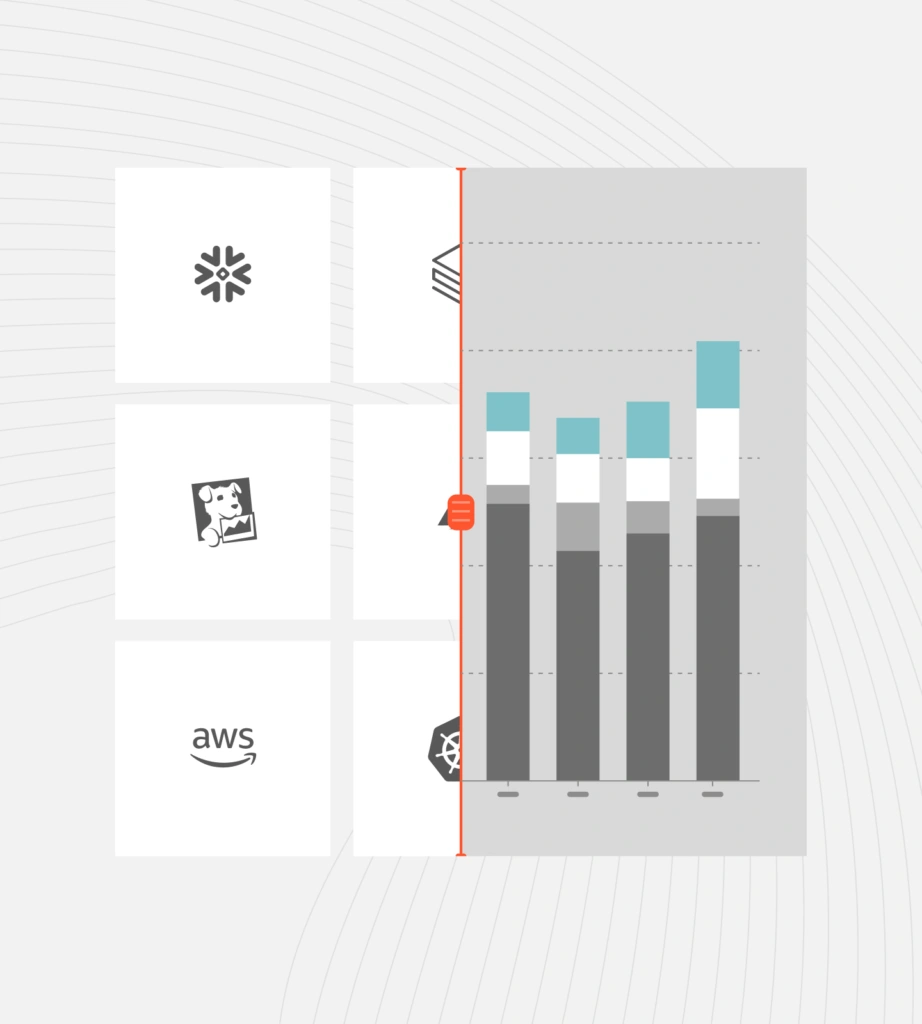
You get it all in one place without sacrificing the clarity, granularity, and actionable intelligence you’ve come to expect from CloudZero, including cost per customer, per team, per project, per feature, per environment, and more. Schedule a demo here to see how CloudZero works.
Limited visibility leads to limited functionality (Nasuni)
A staggering 80% of organizations report widening visibility gaps across their cloud operations and infrastructure. The blindspots hamper their ability to monitor workload performance, security threats, and cloud costs, as a few examples:
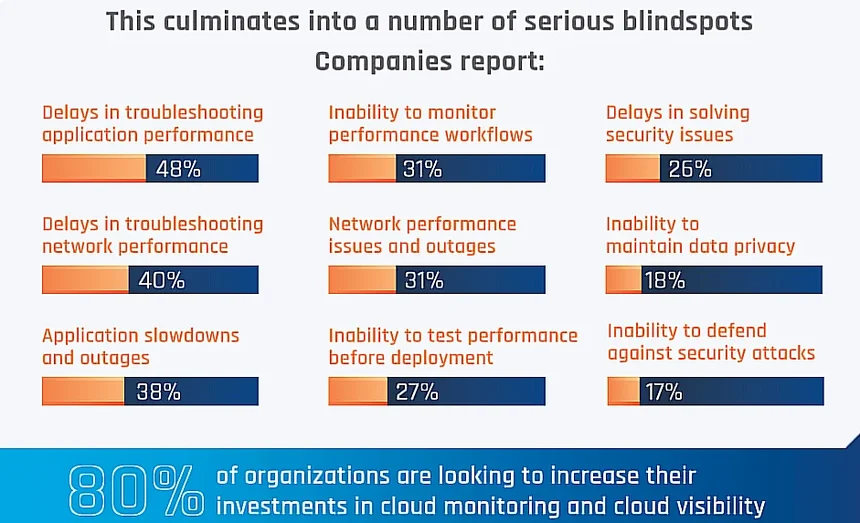
Credit: Challenges associated with a lack of cloud visibility
99% say comprehensive cloud monitoring has direct business value (KeySight)
Most respondents in KeySight’s State of Cloud Monitoring report said they used monitoring solutions to identify performance degradation, malicious traffic by source, and more. Check this out:
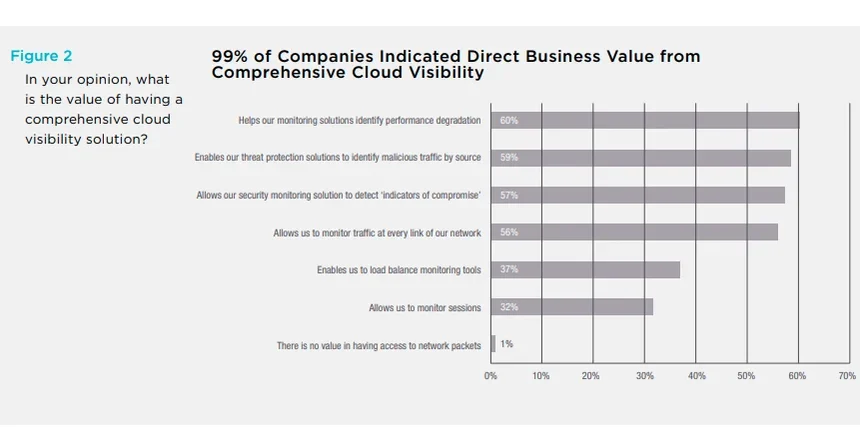
82% of teams use automation to optimize cloud costs (Source: NetApp)
According to the 2023 State of CloudOps report, 70% of organizations have deployed commercial, open-source, or custom cloud cost management solutions. A further 82% believe automation is “critical” or “very valuable” for optimizing cloud ROI and streamlining cloud operations.
At least 30% of organizations need to master shared and untagged costs in the cloud (Source: FinOps Foundation and CloudZero)
In three out of ten cases, shared costs are not split in any way. Another 46% of respondents said they use the proportional model, 32% split shared costs by percentage, and 10% said by even split (average cost per X).
By using a robust cloud monitoring tool, you can identify the people, products, and processes driving your usage patterns, performance, and costs — even if you use a multi-tenant architecture.
There are a few platforms that already do this, such as CloudZero (for multi-cloud and Kubernetes cloud costs) and Kubecost (Kubernetes cost analysis).
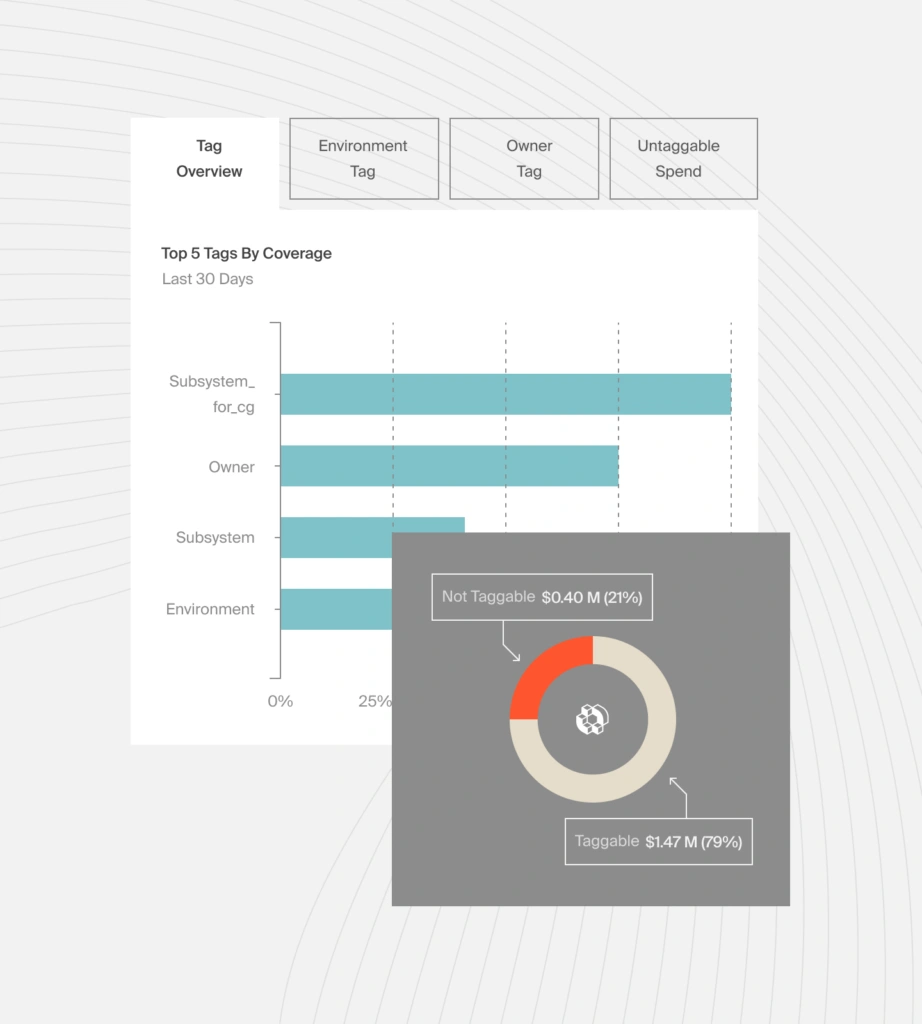
CloudZero lets you capture the cost of tagged, untagged, and untaggable resources in the cloud, as well as allocate 100% of shared costs
Cloud Computing Stats By Industry: Which Industries Use Cloud Services The Most?
While cloud adoption statistics show all industries are embracing cloud services, a closer look shows some sectors invested much more than others.
Cloud-native development is gradually becoming the new normal for tech companies (CNCF)
To fully capitalize on the cloud, tech companies need to leverage cloud-native technologies. A new report from the Cloud Native Computing Foundation shows that they are making progress. The report shows 30% of companies are using cloud-native techniques for development, such as GitOps, containers, and rapid release cycles (CI/CD).
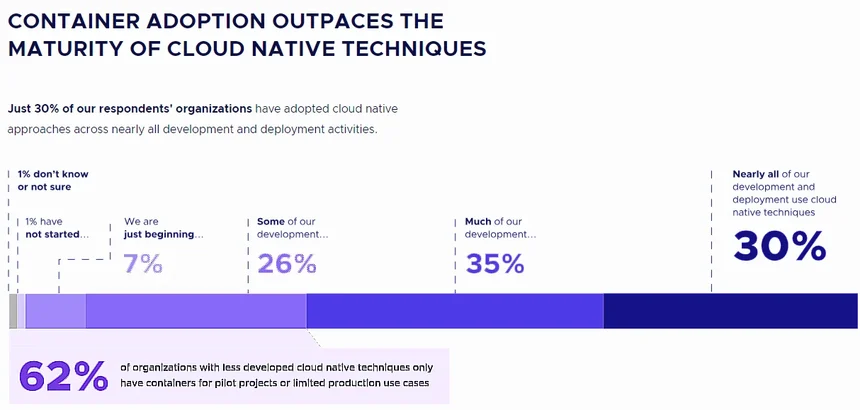
Credit: CNCF 2022 Annual Survey
Health records make up 23.2% of sensitive data in the cloud (SANs Institute)
Healthcare providers are leveraging the cloud to collect, analyze, share, and take action on various diagnoses more quickly. Digital health access helps patients receive the care they need, including quick referrals and information exchanges that can save their lives.
81% of insurers use cloud-based technology to support claims management (IBM)
A further 25% said they use the cloud exclusively. According to IBM, these insurers augment claims processes at scale and speed using AI and ML. These technologies enable them to handle large volumes of data, reduce manual handling, lower error rates, and process more data straight-through.
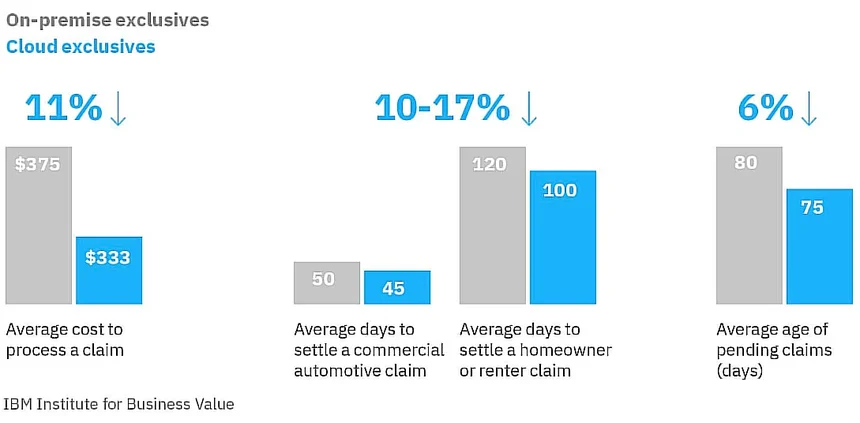
Credit: IBM Institute for Business Value
Retail & Ecommerce is the Most Proactive Cloud Services User (Source: O’Reilly)
The Cloud Adoption survey found the most proactive cloud usage by industry came from Retail & Ecommerce, Finance & Banking, and Technology (software). Government (16%) and electronics & hardware (25%) used cloud services the least in 2022.
Over 30% of commercial real estate leaders will invest in cloud computing (Deloitte)
The Deloitte survey included 400 commercial real estate professionals who were asked what technologies they planned to invest in. The executives agreed that cloud computing was the top priority, followed by blockchain, artificial intelligence, and data analytics.
In manufacturing, smart robots will contribute to Industrial Revolution 4.0 (Research and Markets)
The smart robots will drive factory automation, presenting a $2.13 billion opportunity by 2027. Connected things (IoT) will bring a $24.1 billion opportunity in that time, according to the findings.
63% of educators plan to manage education offerings using curriculum software (The Learning Counsel)
A school management system helps collect and manage data about students, faculty, and staff. Using a cloud-based system can ease the burden of planning lessons for 74% of teachers who feel overwhelmed, allowing them to create student-centric learning programs with ease.
According to Data Bridge, growth in the global school management system sector will average a CAGR of 17.1% between 2021 and 2028. By 2028, the market will be worth $41.26 billion.
Data Analytics And Cloud Storage Statistics
Data lakes, warehouses, marts, and analytics play a major role in enabling cloud computing. The following cloud computing stats provide key examples:
Consider this:
More than 60% of corporate data is now stored in the cloud (Source: Thales Group)
The data includes sensitive information, such as personal details about employees, customers, patients, and business records. Consequently, security analysts feel uneasy about this, according to the 2022 Thales Data Threat Report.
Finance and accounting records are the most common type of sensitive corporate data stored in the public cloud (Source: SANs Institute)
Business records make up nearly 55% of regulated or sensitive data in the public cloud, according to the 2022 Cloud Security Survey by SANs. Data about employees follows (48.9%), while records about customers and health are stored in the cloud quite frequently.
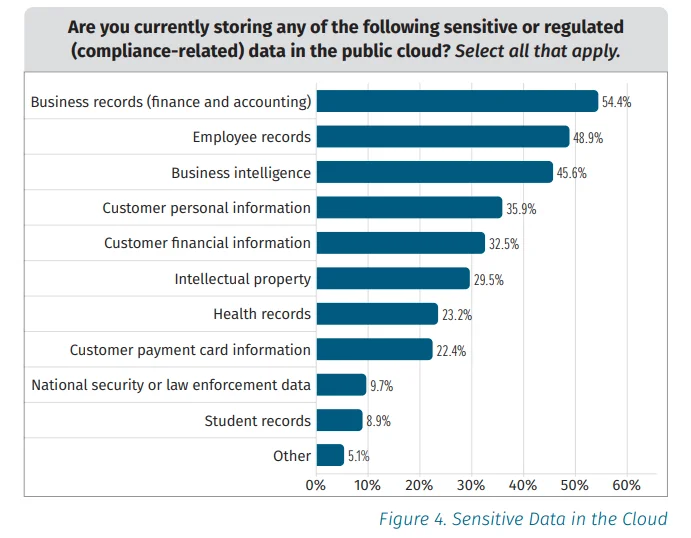
BetterCloud’s SaaSOps survey found similar results:
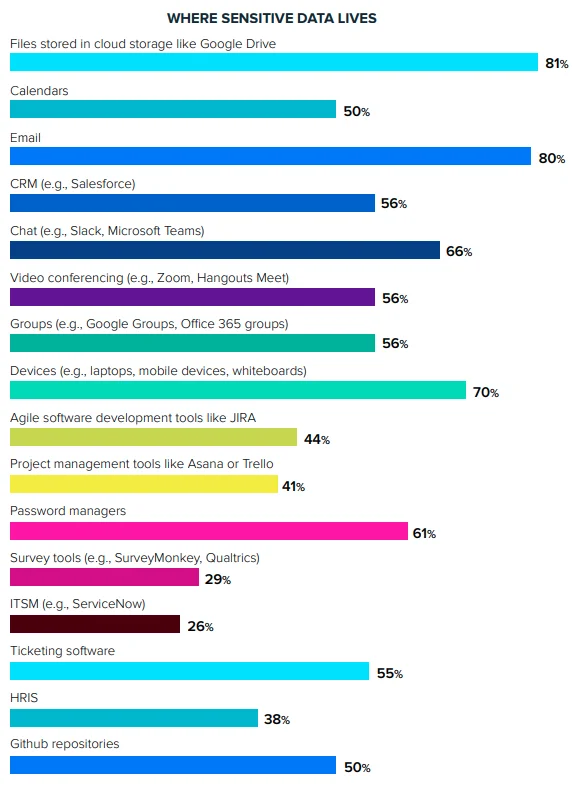
Credit: State of SaaSOps report
The cloud will host more than 100 zettabytes of data by 2025 (Source: Forbes)
Cloud usage generates a colossal amount of data daily. Within three years, the world will generate over 200,000 terabytes of data. Half of that will be stored in the cloud. This emphasizes the increasingly important need to capture, process, analyze, secure, and make the most of the data.
That’s not all.
IoT devices will generate a whole lot of data (Source: Cisco)
By 2025, Cisco estimates there will be more than 75 billion Internet of Things devices worldwide. This figure covers connected devices across B2B and B2C segments, such as smart homes, intelligent security systems, and connected cars.
Data analytics is key to enabling digital transformation (Source: Gartner)
Data is a critical organizational asset for 90% of organizations. That makes data analytics a core competency every organization will want to develop. Data fabrics use APIs to break down silos, allowing organizations to consolidate data access, management, and security across multiple cloud providers.
A centralized data management framework reduces vendor lock-in and allows organizations to utilize their distributed services to gain a unified view of their operations.
46% of European companies store all their data in the cloud (Source: Thales)
Thales Europe found that 43% of the data is classified as ‘sensitive’. While a quarter of companies admit to suffering a breach in the past year, only 54% of their sensitive data is encrypted.
Cloud computing is a modern data protection strategy (Source: Veeam)
The cloud plays a crucial role in today’s data protection strategy, according to half of the surveyed businesses. They told Veeam that they moved to the cloud as a way to do disaster recovery using a cloud service (54%), to migrate workloads to the cloud (50%), and to shift workloads between clouds (48%).
Cloud Security Statistics
Cloud computing security remains one of the most concerning aspects of operation — and a key barrier to cloud migration for some. Here are some things you need to know.
95% of companies are concerned about cloud security (Source: Fortinet)
Fortinet reported that almost everyone is moderately or extremely concerned about security in the cloud.
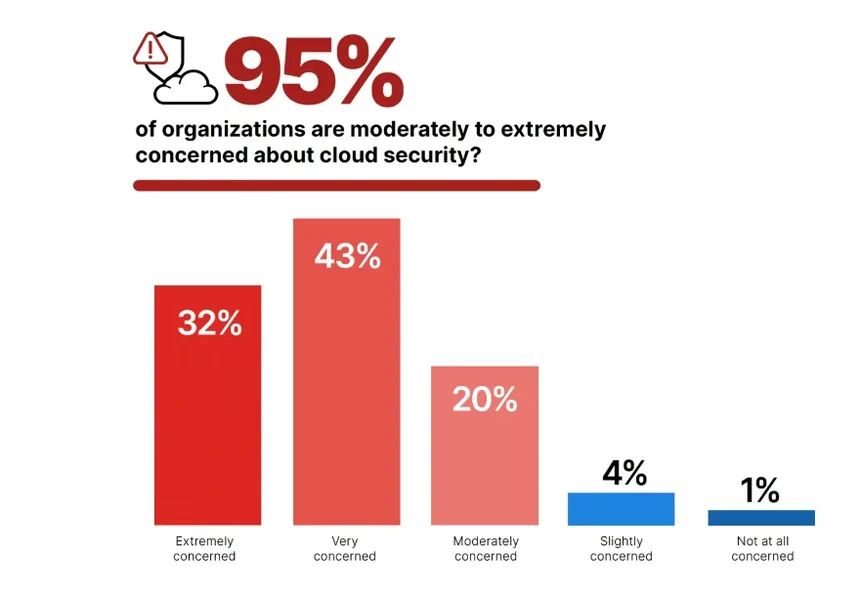
The concern is justified, considering that:
Cybercrime costs an organization about $13.0 million on average (Source: Accenture)
The State of CyberSecurity Report by Accenture examines the cost of cybercrime and makes it easier to quantify the economic cost of malicious activities in the cyberspace.
The cost of a data breach in 2023 was about $4.5 million on average (Source: IBM)
IBM’s Cost of Data Breach Report found the financial consequences of a single breach can take $4.45 million to resolve, up from $4.35 million in 2022. The healthcare sector is particularly sensitive, with the average breach costing the most of any sector; $10.10 million (IBM).
Ransomware makes up 28% of attacks (Source: IBM)
While ransomware reduced 9% in 2022, it is still a leading threat in cyberspace. Phishing is also a major challenge, with most cybercriminals attempting to get information by mimicking Microsoft, Apple, and Google brands.
Data breaches exposed more than 22 billion records (Source: Risk Based Security and FlashPoint)
The breaches occurred through 4,145 publicly disclosed breaches, down 5% from 2020. But that number could increase 5% in 2022 and beyond, according to the survey findings. .
73% believe cloud technology has created more complexity (Source: Fujitsu and Vitreous World)
The survey also found that 70% of CIOs think cloud technologies mean they have less control. This inadequate control is particularly felt in cloud cost management, which is the biggest challenge in cloud computing today – as shared earlier.
IT downtime costs on average $5,600 per minute (Source: Vitreous World)
This is crippling for companies reliant on online access, like Ecommerce and streaming services players. Meanwhile, stricter regulations require organizations to take legal responsibility for their customer data, raising the stakes – and the financial ramifications of an outage.
It takes almost two hours on average to resolve server downtime (Source: Veeam)
The Data Protection Trends Report showed that 95% of organizations struggle with unexpected outages. The average outage lasts almost 2 hours (117 minutes).
For a High Priority application, an hour of downtime costs $67,651, while for a Normal application, it costs $61,642. Clearly, downtime is unacceptably costly in today’s business environment.
For enterprises, the cost can be wildly higher.
A single hour of downtime costs enterprises over $100,000 (Source: Accenture)
That is according to nearly all (98%) of surveyed leaders. Some 40% of enterprises said they lost $1-$5 million in just one hour of downtime. This eye-watering cost excludes legal fees, fines, or penalties.
Add Service Level Agreement (SLA) obligations and other forms of inconveniences and business losses, and you are looking at even larger damage.
Misconfiguration is responsible for 68% of issues (Source: Fortinet)
Organizations ranked the following threats as the most significant security threats to their public clouds:
- Misconfiguration (68%)
- Unauthorized access (58%)
- Insecure interfaces (52%)
- Hijacking of accounts (50%)
Meanwhile, most apps have fewer than three security certifications, while IT-owned apps are more likely to use SSO. Similarly, many organizations had not prioritized cybersecurity and compliance:
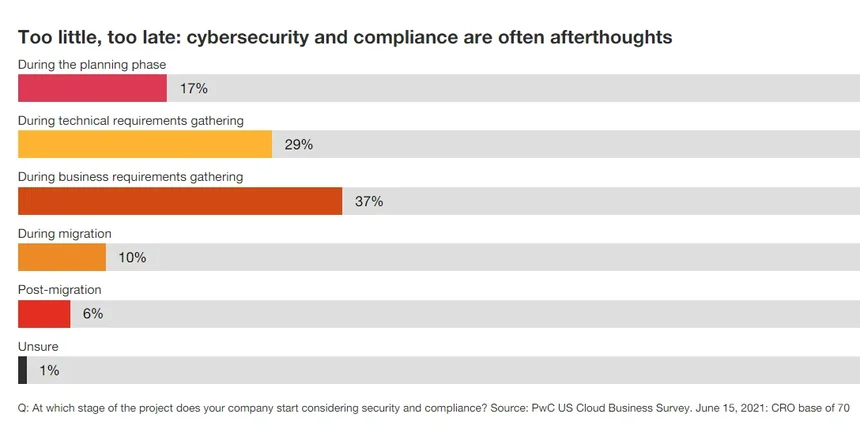
Zero trust policies are a thing now (Source: Fortnet)
ore organizations are implementing zero trust policies to improve their cloud security, according to Fortinet. Consider this:
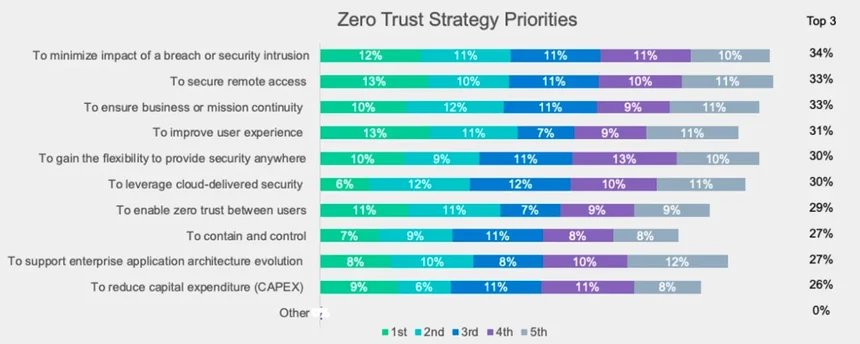
What organizations hope implementing zero trust policies will achieve.
Statistics About Factors That Are Limiting Cloud Adoption
Apart from cloud security concerns, organizations pointed several other issues as the biggest unforeseen factors that slow or stop cloud adoption.
Managing costs is the biggest challenge to cloud adoption (Source: Flexera)
Among those surveyed for the State of the Cloud Report, managing cloud costs and security were the main reasons for not fully embracing cloud computing. This is true for both enterprises and SMBs.
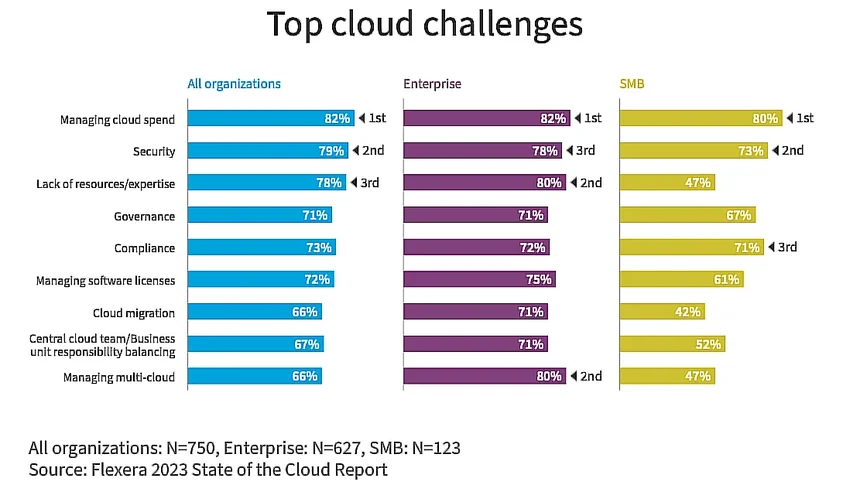
Credit: State of the Cloud Report for 2023
In addition, enterprises and SMBs have issues acquiring expertise and managing compliance in the cloud, respectively.
Low visibility is a major barrier to cloud adoption (Source: Fortnet)
According to findings in the 2022 Cybersecurity Insiders Report by Fortinet, cloud adoption limitations include
- Lack of visibility (49%)
- High cost (43%)
- Lack of control (42%)
- Lack of staff resources or expertise (39%)
- Lack of security (22%)
A major obstacle to controlling cloud costs is not getting “true visibility” into costs:
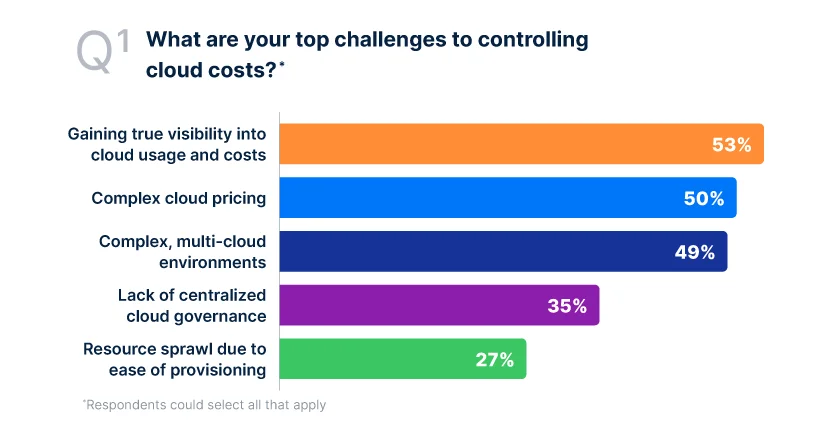
Credit: Anodot
Integration issues cause governance challenges (Source: PwC)
The US Cloud Business Survey by PwC reported that a lack of integration with existing systems, insufficient talent, and lacking expertise are other top challenges to adopting cloud computing:

There is more.
SaaS companies are moving away from massive discounting (OpenView Venture Capital)
A good 68% of SaaS companies are discounting their prices in less than a quarter of all deals according to the State of SaaS Pricing report.

A further 29% report that their sales team offers “very little discounting“. This is helping them generate more revenues and maintain their margins.
But what if you want to encourage new subscriptions and renewals?
The problem may not have been discounting. They may have been unsure how much discount to offer – especially without hurting their margins. We recommend you use cost per customer to determine how much you spend to support a specific customer — like this:
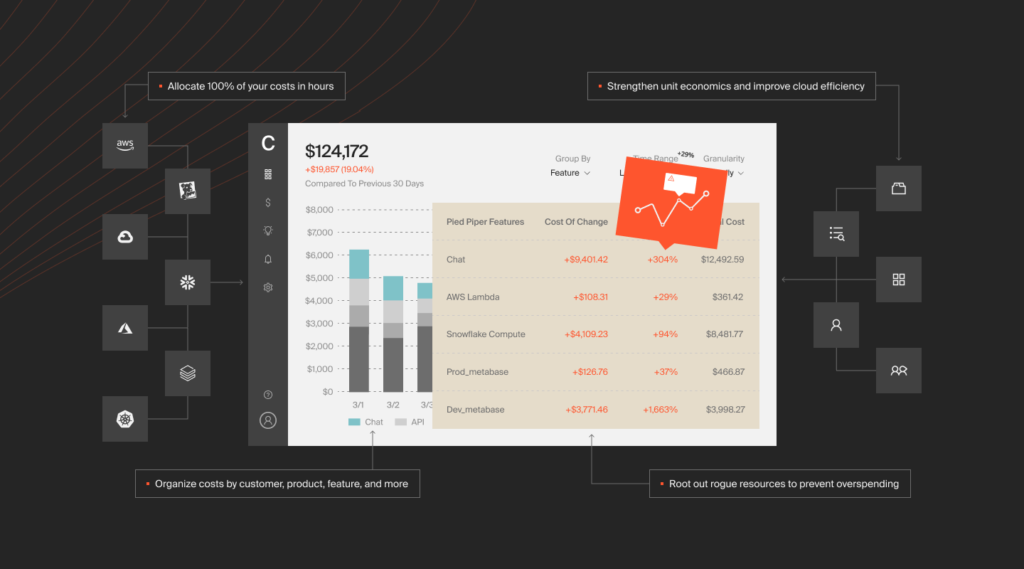
This information can help you pinpoint how much you can discount that particular customer without compromising your margins on their contract.
What Are The Top Cloud Computing Initiatives In 2024?
In response to those challenges, many organizations have or are implementing initiatives to counter them. Here are some top cloud computing statistics that show how.
Serverless is reaching mainstream adoption (Source: Datadog)
The 2022 State of Serverless report shows more than half of AWS, Azure, and Google Cloud users have embraced serverless computing.

AWS Lambda and Google Cloud Run are particularly popular. Companies are using serverless to improve performance, streamline server management, and tighten control over cloud costs.
6 out of 10 organizations plan to optimize their cloud usage (Source: Flexera)
Most respondents said they planned to save money, migrate more workloads to the cloud, and use SaaS over on-premises deployments.

Organizations want to use cloud computing to meet ESG goals (Source: PwC)
Some companies are leveraging cloud computing to meet their environmental, social, and governance (ESG) goals. Check this out:

In three years, the remote desktop market will exceed $4 billion (Source: Research and Markets)
This figure covers sales from organizations, sole traders, and partnerships. RXemote desktop software lets local users access remote computers’ desktop environments and resources remotely. This has the potential to further streamline remote working, collaboration, and technical customer support.
Edge computing is on track to become a $251 billion market (Source: IDC)
The findings show that edge computing will generate $250.6 billion in hardware, software, and services spend by 2024. It also shows companies in the energy, industrial, and transportation sectors are already seeing benefits. Some insiders estimate 33% of all workloads could run at the edge by 2025.
Green computing is on the rise (Source: GEC)
By 2025, IT could account for 8% of global GHG emissions. The Green Electronics Council estimates it has helped save nearly 400 million megawatt-hours through the 1.5 billion green products it has recommended so far.
What’s Next?
Ultimately, we’ll continue to see more workloads move to the cloud as the benefits of adopting cloud computing outweigh the challenges for many players.
We get it, though. It can be frustrating not knowing where your cloud spend is going — especially when you don’t know whether you are investing more or simply overspending.
We know this because we’ve helped:
- Drift reduce its annual cloud cost by $2.4 million.
- Obsidian reduced its AWS bill by 25%.
- ResponseTap reduced its overall AWS spend by 18%.
- MalwareBytes conducts granular unit economics, in particular, cost per product, to know exactly where their cloud costs are going.
- Remitly allocates 50% more costs without tagging.
- Applause integrated CloudZero and saw their cloud spend drop by 23%
CloudZero will help you transform your cloud bill from this:
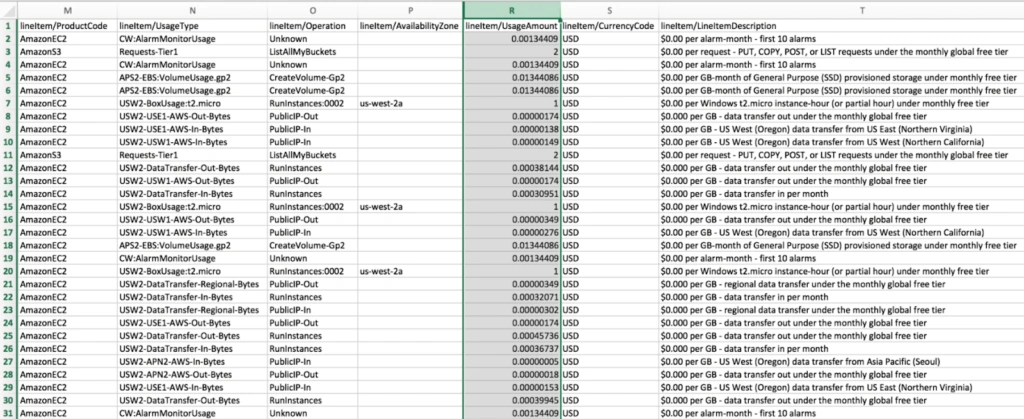
To this:
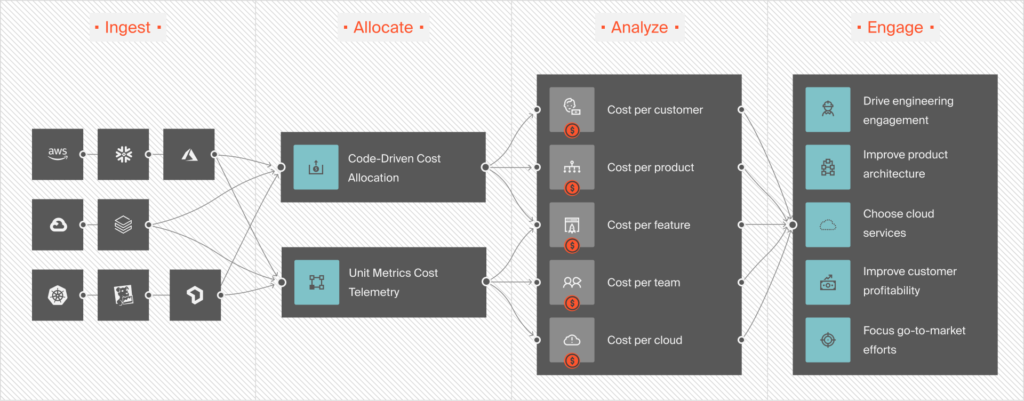
Simple, granular, and actionable cloud cost insights at your fingertips, including cost per customer, team, software feature, product, engineering project, computing environment, and more.
CloudZero’s unique code-driven cost optimization approach helps you achieve all this without endless cost allocation tags.
But don’t take our word for it.  to discover how CloudZero can help you manage and optimize your costs across AWS, GCP, Azure, Snowflake, and Kubernetes, all in one place.
to discover how CloudZero can help you manage and optimize your costs across AWS, GCP, Azure, Snowflake, and Kubernetes, all in one place.








